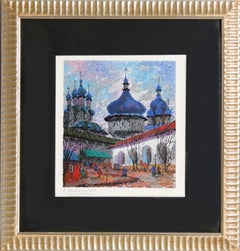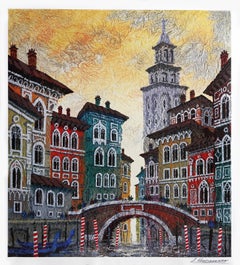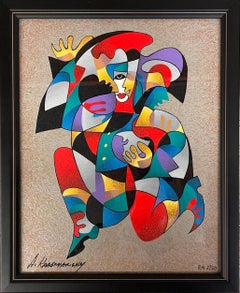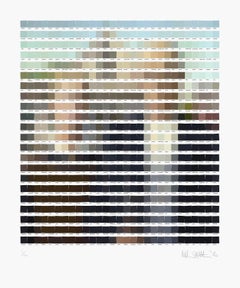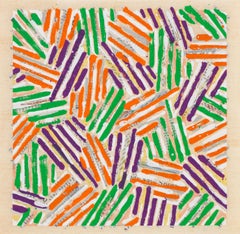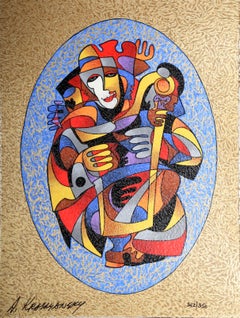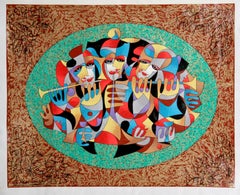Anatole Krasnyansky Prints and Multiples
Russian, b. 1930
is a contemporary American-Ukrainian artist, best known for his watercolors and cityscapes. His work conflates themes of music, theater, architecture, and culture through colorful figurations set in non-Euclidean space. Born in 1930 in Kiev, Ukraine, Krasnyansky earned his master’s in architecture and fine art before emigrating from the Soviet Union in 1975 to pursue his career in Los Angeles, CA. His structural aesthetic is shaped by his previous work as an architect, as well as having served as a scenic artist in the theater industries. Notably, Krasnyansky developed a unique process of textural watercolor painting, where his paper works reference Eastern culture and heritage through color relationships and architectural features. Currently living and working in Los Angeles, CA, Krasnyansky has exhibited internationally, including at institutions such as Stanford University in Palo Alto and at the University of Los Angeles.to
5
1
4
1
1
Overall Width
to
Overall Height
to
5
1
14
1,183
938
886
817
1
9
2
3
1
10
2
6
4
2
2
1
1
1
1
1
1
1
1
1
1
1
9
2
8
4
12
Artist: Anatole Krasnyansky
Old Towers of Rostov Kremlin, Serigraph, signed and numbered in pencil
By Anatole Krasnyansky
Located in Long Island City, NY
Anatole Krasnyansky, Ukrainian/American (1930 - ) - Old Towers of Kyiv, Medium: Screenprint, signed and numbered in pencil, Edition: 55/350, Image Size: 10.25 x 9.25 inches, Size: 1...
Category
Late 18th Century Anatole Krasnyansky Prints and Multiples
Materials
Screen
Blue Bird
By Anatole Krasnyansky
Located in San Francisco, CA
This artwork titled "Blue Bird' c.1990 is a dye sublimation print on aluminium by Ukrainian/American artist Anatole Krasnyansky. It is hand signed and number...
Category
Late 20th Century Surrealist Anatole Krasnyansky Prints and Multiples
Materials
Other Medium
Old City of Warsaw
By Anatole Krasnyansky
Located in San Francisco, CA
This artwork titled "Old City of Warsaw" 1994 is an original color serigraph by Ukrainian/American artist Anatole Krasnyansky, 1930-2023. It is hand signed, titled and numbered 117/...
Category
Late 20th Century Surrealist Anatole Krasnyansky Prints and Multiples
Materials
Screen
Venice Yellow Sunset, Seriolithograph, signed in plate by Anatole Krasnyansky
By Anatole Krasnyansky
Located in Long Island City, NY
Anatole Krasnyansky, Ukrainian/American (1930 - ) - Venice Yellow Sunset, Year: 2003, Medium: Seriolithograph, signed in plate, Image Size: 27.5 x 25 i...
Category
Early 2000s Anatole Krasnyansky Prints and Multiples
Materials
Lithograph
Harlequin, Cubist Screenprint by Anatole Krasnyansky
By Anatole Krasnyansky
Located in Long Island City, NY
This surreal, contemporary-cubist screenprint by the artist is reminiscent of a harlequin kneeling before an audience, one hand raised. The piece is nicely framed and is signed and n...
Category
Late 20th Century Abstract Expressionist Anatole Krasnyansky Prints and Multiples
Materials
Screen
Two Faces
By Anatole Krasnyansky
Located in San Francisco, CA
This artwork "Two Faces" 2006 is an original color serigraph by Ukrainian/American artist Anatole Krasnyansky. It is hand signed and numbered 323/350 in blac...
Category
Late 20th Century Surrealist Anatole Krasnyansky Prints and Multiples
Materials
Screen
Cityscape
By Anatole Krasnyansky
Located in San Francisco, CA
This artwork "Cityscape" c.1990 is an original color serigraph by Ukrainian/American artist Anatole Krasnyansky. It is hand signed and numbered 24/350 in black ink by the artist. The artwork size is 9.35 x 11.15 inches, framed size is 19.75 x 21.75 inches. Custom framed in a gold and silver frame, with off white matting. It is in excellent condition.
About the artist:
Anatole Krasnyansky (born in 1930; Kiev, Ukraine) is a Ukrainian-American artist who has gained prominence by pioneering a new watercolor technique. Krasnyansky added paper texture as a component of his watercolors. With this new process, Krasnyansky added texture and depth to the watercolor medium and expanded its expressive possibilities to a level usually associated with oil painting.
Biography
He was born in Kiev, growing up and living during the times when Ukraine was a part of the U.S.S.R. Krasnyansky received master's degrees in fine art and architecture. He found that the freedom of expression that he needed in his artwork could not be found within the strictures of the Soviet Union and moved to the United States in 1975.
In the U.S., Krasnyansky found valuable use for his knowledge of architecture, design and his imagination. and found success in multiple artistic pursuits. Almost surreal, Krasnyansky’s figures are recognizable form while incorporating elements of his Eastern heritage, the cubist ideas of Picasso and Braque, and as well as American culture.
Accomplishments
Krasnyansky began working as a scenic artist for ABC and CBS, including the production of two Academy Awards shows. He became a set designer for Universal Studios (credits including The Blues Brothers and Battlestar Galactica...
Category
Late 20th Century Surrealist Anatole Krasnyansky Prints and Multiples
Materials
Screen
Street of Old Prague, Signed Screenprint by Anatole Krasnyansky
By Anatole Krasnyansky
Located in Long Island City, NY
Anatole Krasnyansky, Ukrainian/American (1930 - ) - Street of Old Prague, Medium: Screenprint, signed and numbered in marker, Edition: 337/350, Size: 14 x 12.25 in. (35.56 x 31.12 c...
Category
1980s Anatole Krasnyansky Prints and Multiples
Materials
Screen
The City 's Conscience
By Anatole Krasnyansky
Located in San Francisco, CA
This artwork titled "The City 's Conscience" 2006 is an original color serigraph by Ukrainian/American artist Anatole Krasnyansky. It is hand signed and numbered 45/495 in black ink by the artist. The artwork size is 24 x 17.5 inches, framed size is 29.5 x 23 inches. Custom framed in a wooden black and gold frame, with fabric liner. It is in excellent condition.
About the artist:
Anatole Krasnyansky (born in 1930; Kiev, Ukraine) is a Ukrainian-American artist who has gained prominence by pioneering a new watercolor technique. Krasnyansky added paper texture as a component of his watercolors. With this new process, Krasnyansky added texture and depth to the watercolor medium and expanded its expressive possibilities to a level usually associated with oil painting.
Biography
He was born in Kiev, growing up and living during the times when Ukraine was a part of the U.S.S.R. Krasnyansky received master's degrees in fine art and architecture. He found that the freedom of expression that he needed in his artwork could not be found within the strictures of the Soviet Union and moved to the United States in 1975.
In the U.S., Krasnyansky found valuable use for his knowledge of architecture, design and his imagination. and found success in multiple artistic pursuits. Almost surreal, Krasnyansky’s figures are recognizable form while incorporating elements of his Eastern heritage, the cubist ideas of Picasso and Braque, and as well as American culture.
Accomplishments
Krasnyansky began working as a scenic artist for ABC and CBS, including the production of two Academy Awards shows. He became a set designer for Universal Studios (credits including The Blues Brothers and Battlestar Galactica...
Category
Late 20th Century Surrealist Anatole Krasnyansky Prints and Multiples
Materials
Screen
Red Sunset, Screenprint, signed and numbered in marker by Anatole Krasnyansky
By Anatole Krasnyansky
Located in Long Island City, NY
Anatole Krasnyansky, Ukrainian/American (1930 - ) - Red Sunset, Medium: Screenprint, signed and numbered in marker, Edition: 303/350, Size: 14 x 12.75 in. (35.56 x 32.39 cm), Descri...
Category
1980s Anatole Krasnyansky Prints and Multiples
Materials
Screen
Silence, Framed Folk Art Screenprint by Anatole Krasnyansky
By Anatole Krasnyansky
Located in Long Island City, NY
Anatole Krasnyansky, Ukrainian/American (1930 - ) - Silence, Year: 2001, Medium: Serigraph on Wove paper, signed and numbered in ink, Edition: 38/350, Size: 11.25 x 10 in. (28.58 x ...
Category
Early 2000s Anatole Krasnyansky Prints and Multiples
Materials
Screen
Art Expo NY, Lithograph Poster by Anatole Krasnyansky
By Anatole Krasnyansky
Located in Long Island City, NY
Anatole Krasnyansky, Ukrainian/American (1930 - ) - Art Expo NY, Year: 1982, Medium: Lithograph Poster, Size: 36 x 24 in. (91.44 x 60.96 cm)
Category
1980s Anatole Krasnyansky Prints and Multiples
Materials
Lithograph
Related Items
NICK SMITH - AMERICAN GOTHIC. Limited edition hand signed Pop Art Design Modern
By Nick Smith
Located in Madrid, Madrid
NICK SMITH - AMERICAN GOTHIC
Date of creation: 2020
Medium: Giclée and screen printed varnish on paper
Edition: 150
Size: 84 x 70 cm
Condition: Brand new, in mint conditions and nev...
Category
2010s Pop Art Anatole Krasnyansky Prints and Multiples
Materials
Varnish, Archival Paper, Giclée, Screen
$3,549
H 33.08 in W 27.56 in
Sans titre (ULAE S13), Jasper Johns, Screenprints, Jasper Johns
By Jasper Johns
Located in Southampton, NY
Silkscreen on Patapar printing parchment paper. Paper Size: 10.125 x 10.125 inches. Inscription: Unsigned and unnumbered, as issued. Notes: From the album, Jasper Johns, Screenprints...
Category
1970s Abstract Expressionist Anatole Krasnyansky Prints and Multiples
Materials
Screen
$4,796 Sale Price
20% Off
H 10.125 in W 10.125 in
Marc Chagall - The Red Rider - Original Lithograph
By Marc Chagall
Located in Collonge Bellerive, Geneve, CH
Marc Chagall - Original Lithograph
The Red Rider
From the unsigned, unnumbered lithograph printed in the literary review XXe Siecle
1957
See Mourlot 191
Dimensions: 32 x 24 cm
Publisher: G. di San Lazzaro.
Marc Chagall (born in 1887)
Marc Chagall was born in Belarus in 1887 and developed an early interest in art. After studying painting, in 1907 he left Russia for Paris, where he lived in an artist colony on the city’s outskirts. Fusing his own personal, dreamlike imagery with hints of the fauvism and cubism popular in France at the time, Chagall created his most lasting work—including I and the Village (1911)—some of which would be featured in the Salon des Indépendants exhibitions. After returning to Vitebsk for a visit in 1914, the outbreak of WWI trapped Chagall in Russia. He returned to France in 1923 but was forced to flee the country and Nazi persecution during WWII. Finding asylum in the U.S., Chagall became involved in set and costume design before returning to France in 1948. In his later years, he experimented with new art forms and was commissioned to produce numerous large-scale works. Chagall died in St.-Paul-de-Vence in 1985.
The Village
Marc Chagall was born in a small Hassidic community on the outskirts of Vitebsk, Belarus, on July 7, 1887. His father was a fishmonger, and his mother ran a small sundries shop in the village. As a child, Chagall attended the Jewish elementary school, where he studied Hebrew and the Bible, before later attending the Russian public school. He began to learn the fundamentals of drawing during this time, but perhaps more importantly, he absorbed the world around him, storing away the imagery and themes that would feature largely in most of his later work.
At age 19 Chagall enrolled at a private, all-Jewish art school and began his formal education in painting, studying briefly with portrait artist Yehuda Pen. However, he left the school after several months, moving to St. Petersburg in 1907 to study at the Imperial Society for the Protection of Fine Arts. The following year, he enrolled at the Svanseva School, studying with set designer Léon Bakst, whose work had been featured in Sergei Diaghilev's Ballets Russes. This early experience would prove important to Chagall’s later career as well.
Despite this formal instruction, and the widespread popularity of realism in Russia at the time, Chagall was already establishing his own personal style, which featured a more dreamlike unreality and the people, places and imagery that were close to his heart. Some examples from this period are his Window Vitebsk (1908) and My Fianceé with Black Gloves (1909), which pictured Bella Rosenfeld, to whom he had recently become engaged.
The Beehive
Despite his romance with Bella, in 1911 an allowance from Russian parliament member and art patron Maxim Binaver enabled Chagall to move to Paris, France. After settling briefly in the Montparnasse neighborhood, Chagall moved further afield to an artist colony known as La Ruche (“The Beehive”), where he began to work side by side with abstract painters such as Amedeo Modigliani and Fernand Léger as well as the avant-garde poet Guillaume Apollinaire. At their urging, and under the influence of the wildly popular fauvism and cubism, Chagall lightened his palette and pushed his style ever further from reality. I and the Village (1911) and Homage to Apollinaire (1912) are among his early Parisian works, widely considered to be his most successful and representative period.
Though his work stood stylistically apart from his cubist contemporaries, from 1912 to 1914 Chagall exhibited several paintings at the annual Salon des Indépendants exhibition, where works by the likes of Juan Gris, Marcel Duchamp and Robert Delaunay were causing a stir in the Paris art world. Chagall’s popularity began to spread beyond La Ruche, and in May 1914 he traveled to Berlin to help organize his first solo exhibition, at Der Sturm Gallery. Chagall remained in the city until the highly acclaimed show opened that June. He then returned to Vitebsk, unaware of the fateful events to come.
War, Peace and Revolution
In August 1914 the outbreak of World War I precluded Chagall’s plans to return to Paris. The conflict did little to stem the flow of his creative output, however, instead merely giving him direct access to the childhood scenes so essential to his work, as seen in paintings such as Jew in Green (1914) and Over Vitebsk (1914). His paintings from this period also occasionally featured images of the war’s impact on the region, as with Wounded Soldier (1914) and Marching (1915). But despite the hardships of life during wartime, this would also prove to be a joyful period for Chagall. In July 1915 he married Bella, and she gave birth to a daughter, Ida, the following year. Their appearance in works such as Birthday (1915), Bella and Ida by the Window (1917) and several of his “Lovers” paintings give a glimpse of the island of domestic bliss that was Chagall’s amidst the chaos.
To avoid military service and stay with his new family, Chagall took a position as a clerk in the Ministry of War Economy in St. Petersburg. While there he began work on his autobiography and also immersed himself in the local art scene, befriending novelist Boris Pasternak, among others. He also exhibited his work in the city and soon gained considerable recognition. That notoriety would prove important in the aftermath of the 1917 Russian Revolution when he was appointed as the Commissar of Fine Arts in Vitebsk. In his new post, Chagall undertook various projects in the region, including the 1919 founding of the Academy of the Arts. Despite these endeavors, differences among his colleagues eventually disillusioned Chagall. In 1920 he relinquished his position and moved his family to Moscow, the post-revolution capital of Russia.
In Moscow, Chagall was soon commissioned to create sets and costumes for various productions at the Moscow State Yiddish Theater, where he would paint a series of murals titled Introduction to the Jewish Theater as well. In 1921, Chagall also found work as a teacher at a school for war orphans. By 1922, however, Chagall found that his art had fallen out of favor, and seeking new horizons he left Russia for good.
Flight
After a brief stay in Berlin, where he unsuccessfully sought to recover the work exhibited at Der Sturm before the war, Chagall moved his family to Paris in September 1923. Shortly after their arrival, he was commissioned by art dealer and publisher Ambroise Vollard to produce a series of etchings for a new edition of Nikolai Gogol's 1842 novel Dead Souls. Two years later Chagall began work on an illustrated edition of Jean de la Fontaine’s Fables, and in 1930 he created etchings for an illustrated edition of the Old Testament, for which he traveled to Palestine to conduct research.
Chagall’s work during this period brought him new success as an artist and enabled him to travel throughout Europe in the 1930s. He also published his autobiography, My Life (1931), and in 1933 received a retrospective at the Kunsthalle in Basel, Switzerland. But at the same time that Chagall’s popularity was spreading, so, too, was the threat of Fascism and Nazism. Singled out during the cultural "cleansing" undertaken by the Nazis in Germany, Chagall’s work was ordered removed from museums throughout the country. Several pieces were subsequently burned, and others were featured in a 1937 exhibition of “degenerate art” held in Munich. Chagall’s angst regarding these troubling events and the persecution of Jews in general can be seen in his 1938 painting White Crucifixion.
With the eruption of World War II, Chagall and his family moved to the Loire region before moving farther south to Marseilles following the invasion of France. They found a more certain refuge when, in 1941, Chagall’s name was added by the director of the Museum of Modern Art (MOMA) in New York City to a list of artists and intellectuals deemed most at risk from the Nazis’ anti-Jewish campaign. Chagall and his family would be among the more than 2,000 who received visas and escaped this way.
Haunted Harbors
Arriving in New York City in June 1941, Chagall discovered that he was already a well-known artist there and, despite a language barrier, soon became a part of the exiled European artist community. The following year he was commissioned by choreographer Léonide Massine to design sets and costumes for the ballet Aleko, based on Alexander Pushkin’s “The Gypsies” and set to the music of Pyotr Ilyich Tchaikovsky.
But even as he settled into the safety of his temporary home, Chagall’s thoughts were frequently consumed by the fate befalling the Jews of Europe and the destruction of Russia, as paintings such as The Yellow Crucifixion...
Category
1950s Surrealist Anatole Krasnyansky Prints and Multiples
Materials
Lithograph
$2,904
H 12.6 in W 9.45 in D 0.04 in
Marc Chagall - The Candlestick - Original Lithograph
By Marc Chagall
Located in Collonge Bellerive, Geneve, CH
The Candlestick, from Jean Leymarie, Vitraux pour Jérusalem (Jerusalem Windows), André Sauret, Monte Carlo, 1962 (see M. 366-72; see C. books ...
Category
1960s Surrealist Anatole Krasnyansky Prints and Multiples
Materials
Lithograph
$2,489
H 12.8 in W 9.65 in D 0.04 in
Marc Chagall (1887-1985) "Daphnis Discovers Chloe"
By Marc Chagall
Located in Los Angeles, CA
Marc Chagall (1887-1985)
"Daphnis Discovers Chloe"
from ...
Category
1960s Abstract Expressionist Anatole Krasnyansky Prints and Multiples
Materials
Lithograph
$36,000
H 32 in W 25.5 in D 1.5 in
Otono Floral (Sexual Spring-like Winter)
By Julian Schnabel
Located in New York, NY
Otono Floral, 1995
Hand-painted, 15-color screenprint with poured resin
40 x 30 inches (102 x 76 cm) Edition of 80 signed in pencil and stamped on verso
"Sexual Spring-like Win...
Category
1990s Abstract Expressionist Anatole Krasnyansky Prints and Multiples
Materials
Screen
Marc Chagall - Inspiration - Original Lithograph from "Chagall Lithographe" v. 2
By Marc Chagall
Located in Collonge Bellerive, Geneve, CH
Marc Chagall
Original Lithograph from Chagall Lithographe 1957-1962. VOLUME II.
1963
Dimensions: 32 x 24 cm
From the unsigned edition of 10000 copies without margins
Reference: Mourlot 398
Condition : Excellent
Marc Chagall (born in 1887)
Marc Chagall was born in Belarus in 1887 and developed an early interest in art. After studying painting, in 1907 he left Russia for Paris, where he lived in an artist colony on the city’s outskirts. Fusing his own personal, dreamlike imagery with hints of the fauvism and cubism popular in France at the time, Chagall created his most lasting work—including I and the Village (1911)—some of which would be featured in the Salon des Indépendants exhibitions. After returning to Vitebsk for a visit in 1914, the outbreak of WWI trapped Chagall in Russia. He returned to France in 1923 but was forced to flee the country and Nazi persecution during WWII. Finding asylum in the U.S., Chagall became involved in set and costume design before returning to France in 1948. In his later years, he experimented with new art forms and was commissioned to produce numerous large-scale works. Chagall died in St.-Paul-de-Vence in 1985.
The Village
Marc Chagall was born in a small Hassidic community on the outskirts of Vitebsk, Belarus, on July 7, 1887. His father was a fishmonger, and his mother ran a small sundries shop in the village. As a child, Chagall attended the Jewish elementary school, where he studied Hebrew and the Bible, before later attending the Russian public school. He began to learn the fundamentals of drawing during this time, but perhaps more importantly, he absorbed the world around him, storing away the imagery and themes that would feature largely in most of his later work.
At age 19 Chagall enrolled at a private, all-Jewish art school and began his formal education in painting, studying briefly with portrait artist Yehuda Pen. However, he left the school after several months, moving to St. Petersburg in 1907 to study at the Imperial Society for the Protection of Fine Arts. The following year, he enrolled at the Svanseva School, studying with set designer Léon Bakst, whose work had been featured in Sergei Diaghilev's Ballets Russes. This early experience would prove important to Chagall’s later career as well.
Despite this formal instruction, and the widespread popularity of realism in Russia at the time, Chagall was already establishing his own personal style, which featured a more dreamlike unreality and the people, places and imagery that were close to his heart. Some examples from this period are his Window Vitebsk (1908) and My Fianceé with Black Gloves (1909), which pictured Bella Rosenfeld, to whom he had recently become engaged.
The Beehive
Despite his romance with Bella, in 1911 an allowance from Russian parliament member and art patron Maxim Binaver enabled Chagall to move to Paris, France. After settling briefly in the Montparnasse neighborhood, Chagall moved further afield to an artist colony known as La Ruche (“The Beehive”), where he began to work side by side with abstract painters such as Amedeo Modigliani and Fernand Léger as well as the avant-garde poet Guillaume Apollinaire. At their urging, and under the influence of the wildly popular fauvism and cubism, Chagall lightened his palette and pushed his style ever further from reality. I and the Village (1911) and Homage to Apollinaire (1912) are among his early Parisian works, widely considered to be his most successful and representative period.
Though his work stood stylistically apart from his cubist contemporaries, from 1912 to 1914 Chagall exhibited several paintings at the annual Salon des Indépendants exhibition, where works by the likes of Juan Gris, Marcel Duchamp and Robert Delaunay were causing a stir in the Paris art world. Chagall’s popularity began to spread beyond La Ruche, and in May 1914 he traveled to Berlin to help organize his first solo exhibition, at Der Sturm Gallery. Chagall remained in the city until the highly acclaimed show opened that June. He then returned to Vitebsk, unaware of the fateful events to come.
War, Peace and Revolution
In August 1914 the outbreak of World War I precluded Chagall’s plans to return to Paris. The conflict did little to stem the flow of his creative output, however, instead merely giving him direct access to the childhood scenes so essential to his work, as seen in paintings such as Jew in Green (1914) and Over Vitebsk (1914). His paintings from this period also occasionally featured images of the war’s impact on the region, as with Wounded Soldier (1914) and Marching (1915). But despite the hardships of life during wartime, this would also prove to be a joyful period for Chagall. In July 1915 he married Bella, and she gave birth to a daughter, Ida, the following year. Their appearance in works such as Birthday (1915), Bella and Ida by the Window (1917) and several of his “Lovers” paintings give a glimpse of the island of domestic bliss that was Chagall’s amidst the chaos.
To avoid military service and stay with his new family, Chagall took a position as a clerk in the Ministry of War Economy in St. Petersburg. While there he began work on his autobiography and also immersed himself in the local art scene, befriending novelist Boris Pasternak, among others. He also exhibited his work in the city and soon gained considerable recognition. That notoriety would prove important in the aftermath of the 1917 Russian Revolution when he was appointed as the Commissar of Fine Arts in Vitebsk. In his new post, Chagall undertook various projects in the region, including the 1919 founding of the Academy of the Arts. Despite these endeavors, differences among his colleagues eventually disillusioned Chagall. In 1920 he relinquished his position and moved his family to Moscow, the post-revolution capital of Russia.
In Moscow, Chagall was soon commissioned to create sets and costumes for various productions at the Moscow State Yiddish Theater...
Category
1960s Surrealist Anatole Krasnyansky Prints and Multiples
Materials
Lithograph
$1,481
H 9.45 in W 12.6 in D 0.04 in
Starry Night - Limited Edition, Figurative, Contemporary, Star, Night, Child
By Charlie Mackesy
Located in Knowle Lane, Cranleigh
Starry Night is a lithograph based on a watercolour by Charlie Mackesy. The edition is limited to 150 and each piece has been signed by Charlie Mackesy...
Category
2010s Other Art Style Anatole Krasnyansky Prints and Multiples
Materials
Lithograph
$3,353
H 11.82 in W 7.88 in D 0.4 in
Hand of Africa - Mandela, Former South African President, Signed Artwork, Hand
By Nelson Mandela
Located in Knowle Lane, Cranleigh
Nelson Mandela, Hand of Africa, Signed Limited Edition Lithograph
Many people are unaware that Nelson Mandela turned his hand to art in his 80's as a way of leaving a legacy for his ...
Category
Early 2000s Contemporary Anatole Krasnyansky Prints and Multiples
Materials
Lithograph
$20,134
H 25.5 in W 20 in D 2 in
TAKASHI MURAKAMI: Who's afraid of red, yellow... Superflat, Japanese Pop Art
By Takashi Murakami
Located in Madrid, Madrid
Takashi Murakami - WHO'S AFRAID OF RED, YELLOW, BLUE AND DEATH
Date of creation: 2011
Medium: Offset lithograph with silver and silkscreen with spot UV varnishing
Edition: 300
Size:...
Category
2010s Pop Art Anatole Krasnyansky Prints and Multiples
Materials
Paper, Varnish, Offset, Screen
$4,728
H 30.32 in W 23.63 in
Rare serigraph "The Grand Party" Giancarlo Impiglia
By Giancarlo Impiglia
Located in Bridgehampton, NY
"The Grand Party:" A rare hand-dated and signed serigraph by world-renowned Giancarlo Impiglia, whose value is bound only to increase.
Born in Rome, Impiglia moved to New York in th...
Category
2010s Art Deco Anatole Krasnyansky Prints and Multiples
Materials
Screen
An old fairy tale 1978, paper, linocut, 35x19 cm
By Nikolai Uvarov
Located in Riga, LV
An old fairy tale
1978, paper, linocut, 35x19 cm
"An Old Fairy Tale" is a linocut artwork created on paper in 1978. The dimensions of the piece are 3...
Category
1970s Surrealist Anatole Krasnyansky Prints and Multiples
Materials
Paper, Linocut
$170 Sale Price
20% Off
H 13.78 in W 7.49 in D 0.04 in
Previously Available Items
Musicians, Screenprint, signed and numbered in marker by Anatole Krasnyansky
By Anatole Krasnyansky
Located in Long Island City, NY
Anatole Krasnyansky, Ukrainian/American (1930 - ) - Musicians, Medium: Screenprint, signed and numbered in marker, Edition: 342/350, Size: 14 x 10.75 in. (35.56 x 27.31 cm), Descrip...
Category
1980s Anatole Krasnyansky Prints and Multiples
Materials
Screen
The Musicians, Serigraph on Canvas, Embellished w/ Marker by Anatole Krasnyansky
By Anatole Krasnyansky
Located in Long Island City, NY
Anatole Krasnyansky, Ukrainian/American (1930 - ) - The Musicians, Medium: Serigraph on Canvas, Embellished with Marker, Edition: 21/21, Size: 22 in. x 28 in. (55.88 cm x 71.12 cm)
Category
Late 18th Century Anatole Krasnyansky Prints and Multiples
Materials
Screen
Ceremony, Screenprint, signed and numbered in marker by Anatole Krasnyansky
By Anatole Krasnyansky
Located in Long Island City, NY
Anatole Krasnyansky, Ukrainian/American (1930 - ) - Ceremony, Medium: Screenprint, signed and numbered in marker, Edition: 241/350, Size: 14 x 10.75 in. (35.56 x 27.31 cm), Descript...
Category
1980s Anatole Krasnyansky Prints and Multiples
Materials
Screen
Band, Screenprint, signed and numbered in marker by Anatole Krasnyansky
By Anatole Krasnyansky
Located in Long Island City, NY
Anatole Krasnyansky, Ukrainian/American (1930 - ) - Band, Medium: Screenprint, signed and numbered in marker, Edition: 179/350, Size: 13.25 x 13.25 in. (33.66 x 33.66 cm), Frame Siz...
Category
1980s Anatole Krasnyansky Prints and Multiples
Materials
Screen
Fly Over The City II, Screenprint by Anatole Krasnyansky
By Anatole Krasnyansky
Located in Long Island City, NY
Anatole Krasnyansky, Ukrainian/American (1930 - ) - Fly Over The City II, Medium: Screenprint, signed and numbered in ink, Edition: 86/350, Size: 24 x 16.25 in. (60.96 x 41.28 cm)
Category
1980s Anatole Krasnyansky Prints and Multiples
Materials
Screen
Old Towers of Kyiv, Signed Folk Art Screenprint by Anatole Krasnyansky
By Anatole Krasnyansky
Located in Long Island City, NY
Anatole Krasnyansky, Ukrainian/American (1930 - ) - Old Towers of Kyiv, Medium: Screenprint, signed and numbered in pencil, Edition: 55/350, Image Size: 10.25 x 9.25 inches, Size: 1...
Category
1980s Folk Art Anatole Krasnyansky Prints and Multiples
Materials
Screen
Gold Framed Anatole Krasnyansky Serigraph
By Anatole Krasnyansky
Located in Plainview, NY
Beautiful framed serigraph of the American / Russain visual artist Anatole Krasnyansky ( 1930-). Hand signed by the artist. and numbered 109/350 Full color on Japanese silk paper.
...
Category
1950s Modern Anatole Krasnyansky Prints and Multiples
Materials
Silk, Wood, Paint
GDANSK NEAR HARBOR (EMBELLISHED)
By Anatole Krasnyansky
Located in Aventura, FL
Hand embellished serigraph in colors on canvas. Hand signed and dated on front, numbered on back by the artist. AP edition of 10. Frame size approx 17 x 16.5 inches.
Artwork is in...
Category
1990s Contemporary Anatole Krasnyansky Prints and Multiples
Materials
Canvas, Screen
Rapture, Pop Art Serigraph by Anatole Krasnyansky
By Anatole Krasnyansky
Located in Long Island City, NY
A serigraph by Anatole Krasnyansky circa 1980. A surrealist harlequin of many faces dancing with playing cards, done is a contemporary cubist style.
Artist: Anatole Krasnyansky
Tit...
Category
1980s Pop Art Anatole Krasnyansky Prints and Multiples
Materials
Screen
Rapture, Pop Art Serigraph by Krasnyansky
By Anatole Krasnyansky
Located in Long Island City, NY
A serigraph by Anatole Krasnyansky circa 1980. A surrealist harlequin of many faces dancing with playing cards, done is a contemporary cubist style. Framed in cherry wood frame.
Ar...
Category
1980s Pop Art Anatole Krasnyansky Prints and Multiples
Materials
Screen
Figurative Abstract Serigraph, 163/350
By Anatole Krasnyansky
Located in Soquel, CA
Vibrant figurative abstract serigraph of boldly colored geometric forms with figural features arranged in a circular composition by Anatole Krasnyan...
Category
Late 20th Century Modern Anatole Krasnyansky Prints and Multiples
Materials
Paper, Ink, Watercolor, Permanent Marker
AUTUMN
By Anatole Krasnyansky
Located in Aventura, FL
Hand embellished serigraph in colors on canvas. Hand signed on front, numbered on back by the artist. Edition of 150. Frame size approx 31 x 27.5 in. Artwork is in excellent condit...
Category
Early 2000s Contemporary Anatole Krasnyansky Prints and Multiples
Materials
Canvas, Screen
Anatole Krasnyansky prints and multiples for sale on 1stDibs.
Find a wide variety of authentic Anatole Krasnyansky prints and multiples available for sale on 1stDibs. If you’re browsing the collection of prints and multiples to introduce a pop of color in a neutral corner of your living room or bedroom, you can find work that includes elements of orange and other colors. You can also browse by medium to find art by Anatole Krasnyansky in screen print, fabric, canvas and more. Much of the original work by this artist or collective was created during the 20th century and is mostly associated with the Surrealist style. Not every interior allows for large Anatole Krasnyansky prints and multiples, so small editions measuring 9 inches across are available. Customers who are interested in this artist might also find the work of Alexander Brodsky and Ilya Utkin, Maurice Pasternak, and Dorothea Tanning. Anatole Krasnyansky prints and multiples prices can differ depending upon medium, time period and other attributes. On 1stDibs, the price for these items starts at $750 and tops out at $2,200, while the average work can sell for $1,200.
